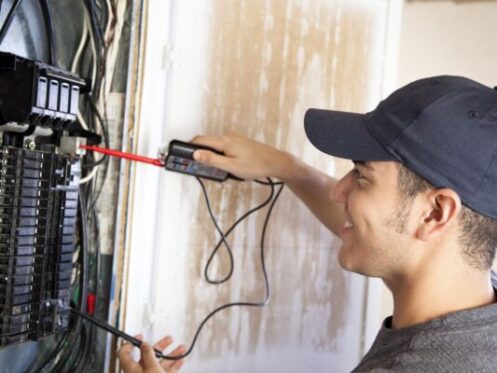A power surge is an unexpected, sometimes dangerous, increase in electrical current that can cause significant damage to your appliances and light fixtures. Understanding what causes a power surge and how to protect your electronics is the key to keeping your home safe.
What Causes Power Surges?
Power surges often occur due to external events such as lightning strikes or malfunctioning utility transformers. They can also be caused by internal events such as the starting and stopping of an air conditioner or a refrigerator motor. Even something as simple as switching on the television can cause a surge if the antenna is not properly grounded.
The Effects of Power Surges
Power surges occur when there is an imbalance between the supply of electricity and the demand for it. This discrepancy causes a sudden spike in voltage that can disrupt electrical circuits and damage sensitive electronics. The result could range from minor problems, like flickering lights, to major malfunctions, like an electrical fire. Here are several ways a power surge can wreak havoc on your electrical components.
1. Overheating
Overheating is an effect of power surges that can impact the operational lifespan of a device. When too much electricity flows through the device, it raises the temperature and creates an environment where the internal components can be severely damaged or even melt. In addition to equipment damage, power surges can cause serious burns if someone touches the overheated material. It is essential to take immediate action to cool down the equipment when possible and to check for any damage that may have occurred due to excessive heat.
2. Short Circuiting
When an electric device or outlet exceeds its accepted voltage levels, the excess energy forces too much current to flow through the wiring and connections. This process forms a circuit in which no endpoint exists for the electricity to travel, causing a situation known as a short circuit. When this happens, sparks may fly, smoke and odor are released, and electrical fires can occur.
If you notice these signs directly after a power surge event, immediately unplug all devices plugged into the outlets in question. If possible, switch off the main fuse and contact a certified electrician to identify whether a short circuit is occurring.
3. Heat Expansion
An increase in electrical current generates an increase in temperature, which can cause the components of vulnerable electronic devices to expand. For example, when too much current runs through a capacitor, it can become damaged due to overheating. This happens because the extra heat causes the electrolyte inside the capacitor to vaporize, leading to bulging, leakage, or complete failure.
4. Component Damage
High voltage levels from a power surge can cause electronic device components to be damaged beyond repair or cease functioning altogether. Integrated circuits (ICs) and printed circuit boards (PCBs) are especially vulnerable to this occurrence.
Do Power Surges Blow Out Your Light Bulbs?
The short answer is yes—a power surge can indeed blow out your light bulbs. A sudden increase in voltage will overload the circuit and burn out the bulb at its weakest point, typically at the filament inside the bulb or within its wiring system. However, not all bulbs are affected by power surges in this way. Incandescent bulbs are more vulnerable to power surges than their LED counterparts. LEDs react differently to changes in voltage due to their solid-state circuitry design and lack of filament structure.
Are There Ways To Protect Your Home From Power Surges?
By following a few simple steps, you can minimize the harm and inconvenience caused by unexpected electrical power surges. Let’s look at what you can do to safeguard your home against power surge damage.
1. Install an Uninterruptible Power Supply (UPS)
An uninterruptible power supply (UPS), or surge protector, installed on your electrical outlets will safeguard your appliances from sudden power surges. A UPS is a device that helps stabilize the electricity supplied to your appliances, providing continuous regulated voltage without the risk of spikes or drops. Several components on a UPS – batteries, power inverters, and rectifiers – work together to do this.
Batteries provide reserve energy if the primary electricity source is disrupted. Power inverters transform the energy stored in batteries from direct current (DC) into alternating current (AC). The rectifier component also regulates current levels and supplies uninterrupted and consistent AC voltage. When selecting a UPS, consider things like wattage, device size, connections included, and discharge rate.
2. Avoid Plugging Appliances Directly Into Wall Sockets
Plugging appliances directly into wall sockets leaves them vulnerable to sudden spikes in voltage. Instead, use extension cords with built-in surge protection. These extension cords provide an additional layer of protection against power surges by preventing the excess voltage from coming into contact with any of your appliances.
3. Have an Electrician Check Your Home Wiring
Have an electrician periodically check the wiring of your home to ensure it is correctly insulated from any outside elements or sources of electricity. If there is inadequate insulation between the wiring and the outside environment, it can cause power surges to travel through the system and damage connected electronics.
4. Replace Any Worn or Damaged Electrical Cables
Electrical cables are a vital part of any building or structure, and it is important to replace worn or damaged ones to prevent future power surges. Hiring an electrician for this task will ensure that the job is done correctly and safely, as experienced electricians understand proper wiring techniques. They may also be aware of innovations in electrical products and be able to suggest an even better replacement than was planned originally.
How Much Will It Cost To Repair an Appliance Damaged by a Power Surge?
When a power surge occurs, the damage to appliances can be significant. Ultimately, the cost to repair the device will depend on exactly what was damaged and how extensive that damage is. An experienced electrician will assess the damage and give you an accurate estimate of repair costs. In some cases, repairing may not be an option at all, and it may be necessary to replace the appliance altogether. In either case, it is prudent to work with a trusted professional in order to get your home back into top shape as quickly as possible.
Contact Electrical Professionals Today!
Are you a resident of the Coachella Valley, Morongo Basin, or the surrounding areas? If so, Home Team Electric can help you upgrade your electrical panel to meet code compliance and install surge protectors. Not only do we offer these valuable services, but we also provide ceiling fan installation, EV charging station installation, and lighting services. A well-functioning electrical system is critical for any home, and Home Team Electric enables you to stay up-to-date on current regulations while at the same time protecting your key appliances from damaging electrical surges. Contact Home Team Electric today to learn more about surge protection and schedule a service call!




